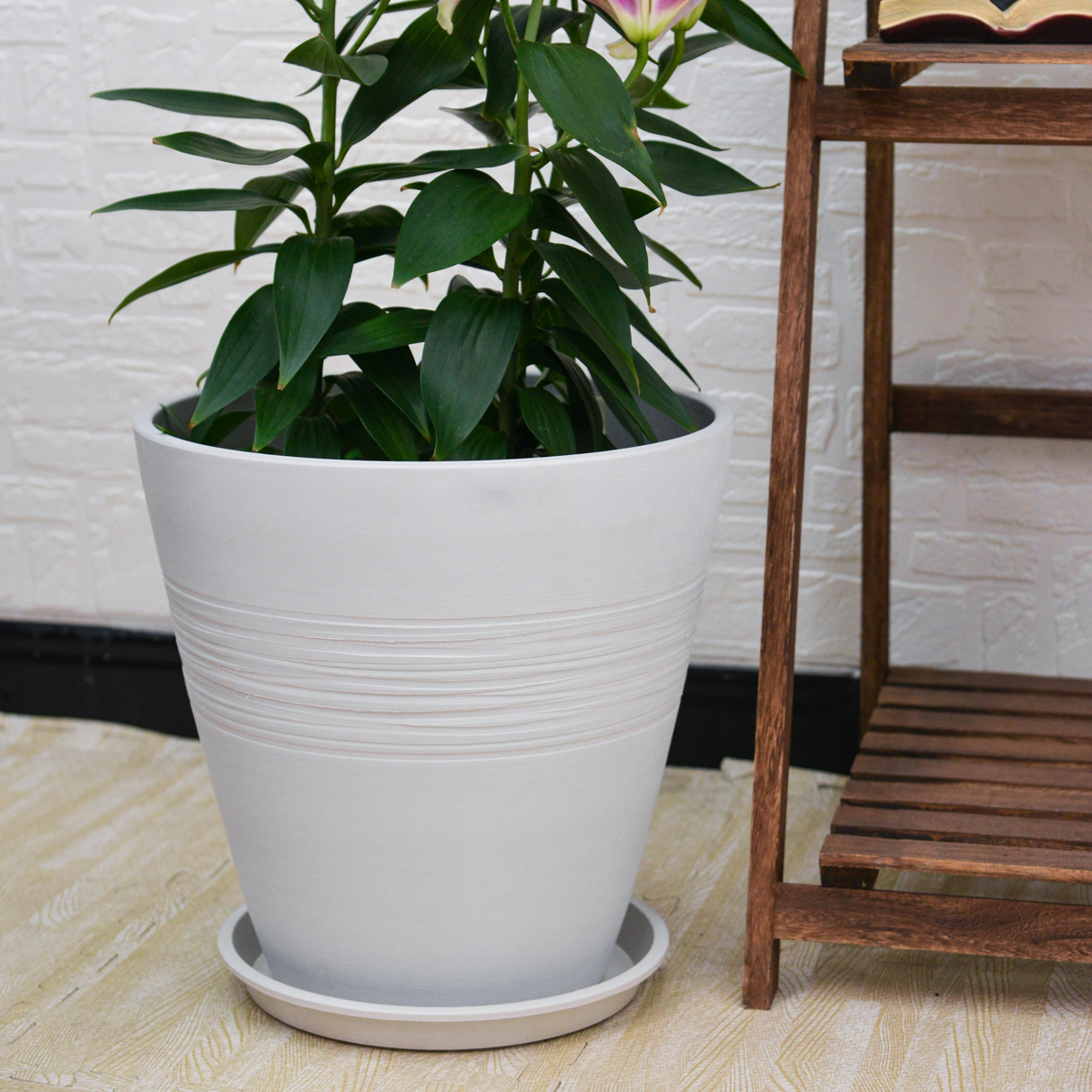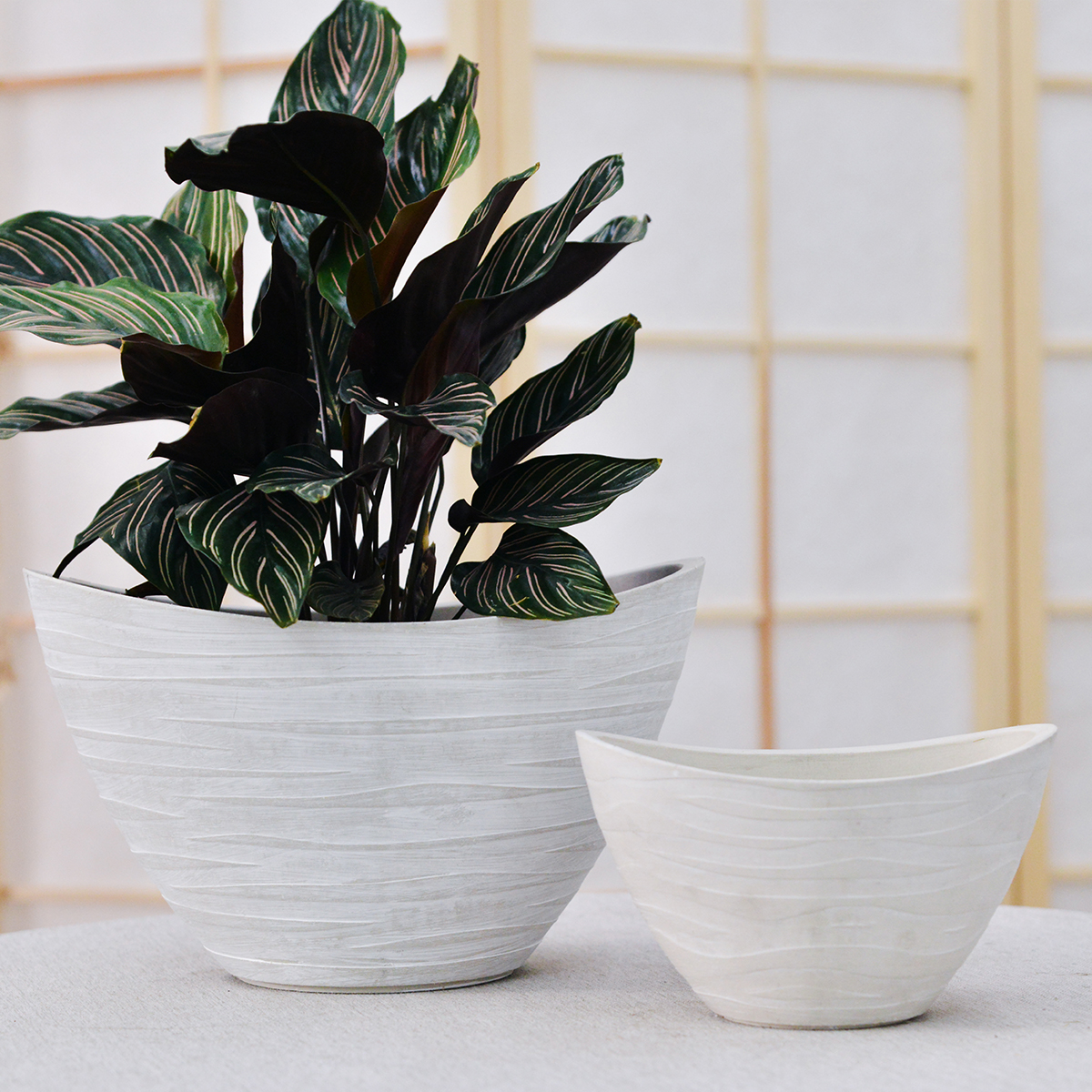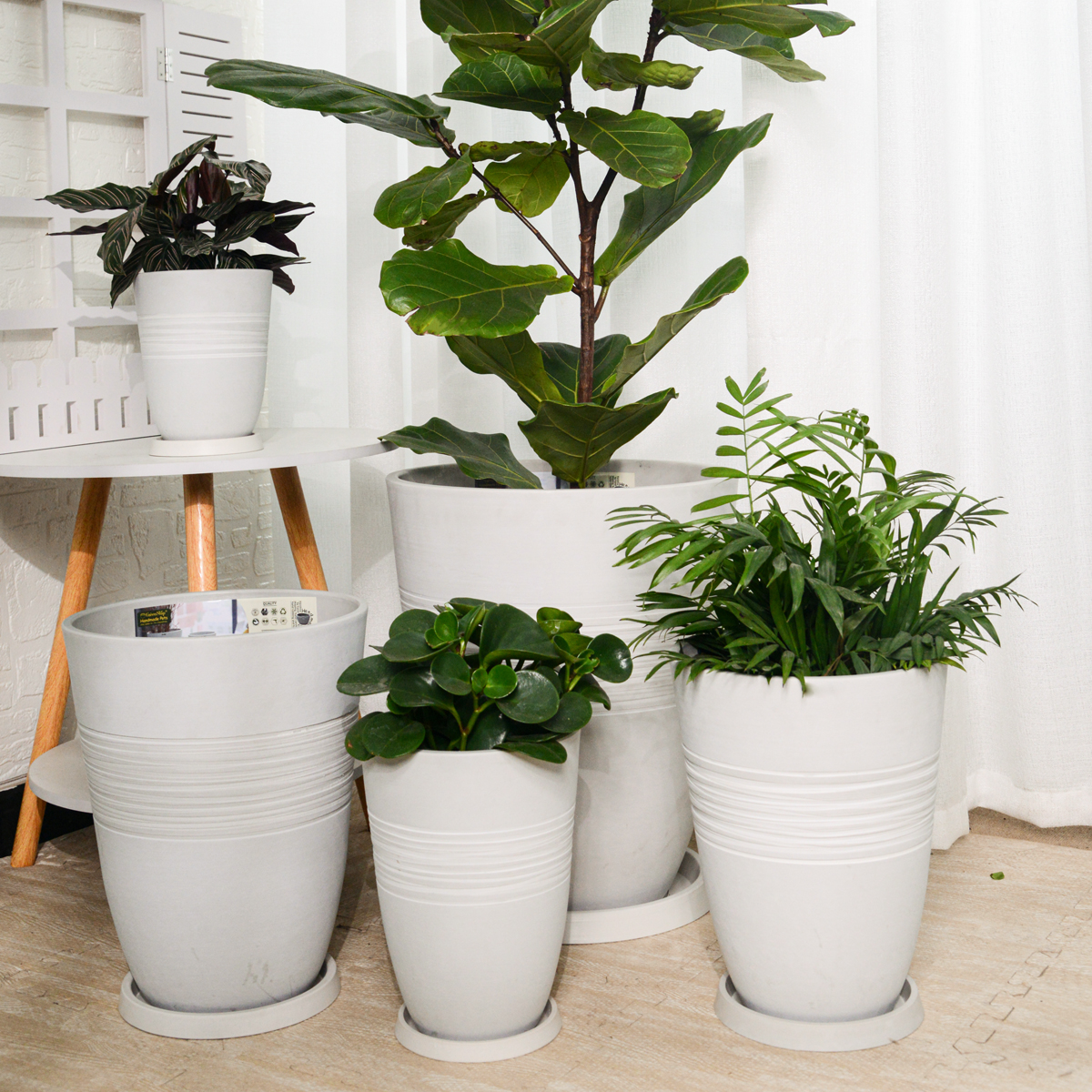Browallia in Pots: The Complete Guide to Growing Bush Violet Outdoors in Containers
Want to add a cascade of star-like blue, purple, or white blooms to your patio, balcony, or garden? Browallia, commonly known as Bush Violet or Amethyst Flower, are wonderfully prolific and rewarding choices for outdoor container gardening, especially in partial shade. Celebrated for their abundance of small, star-shaped flowers, their cool color palette ranging from blues and purples to whites and bi-colors, their long blooming season, and their bushy, cascading habit, Browallia are perfect for adding a touch of delicate beauty and continuous color to shady to partially sunny outdoor spaces. This comprehensive guide will provide you with everything you need to know to grow Browallia successfully in outdoor pots, from selecting the best varieties and containers to mastering essential care techniques for a season filled with Bush Violet blooms and charming appeal.
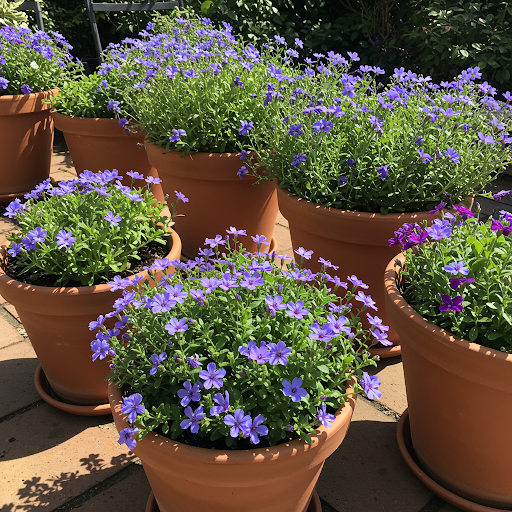
Browallia
What are Browallia (Bush Violets)?
Browallia, commonly called Bush Violet or Amethyst Flower, is a genus of flowering plants in the Solanaceae family (nightshade family), which also includes petunias and tomatoes. Native to tropical regions of the Americas, particularly Central and South America and the Caribbean, Browallia are popular annuals and tender perennials (depending on the climate) grown for their profusion of small, star-shaped flowers and long blooming season. Browallia flowers are famous for their delicate, star-like shape with five pointed petals and their cool, soothing color palette. They come primarily in shades of blue, lavender, violet, and white, with some cultivars offering bi-colors or deeper hues. Browallia plants are characterized by their bushy, often cascading growth habit, small, oval-shaped, bright green leaves, and delicate stems. They exhibit a mounding, bushy, or trailing growth habit, typically reaching 10-18 inches in height and spreading 12-24 inches or more, depending on the cultivar and series. They are known for their profuse blooming, cool color range, long blooming season (spring to fall), shade tolerance, and relative ease of care, making them an invaluable addition to gardens and containers, especially for adding soft, cool colors and delicate textures to shadier locations.
Are Browallia Good for Outdoor Pots?
Yes, Browallia are exceptionally well-suited for outdoor pots and container gardening, and are in fact ideally suited for containers, especially for bringing color to shady patios, balconies, and porches. Their bushy to cascading growth habit, exceptionally long blooming season, tolerance of partial to full shade, and abundance of delicate, star-shaped flowers make them perfect for filling pots, patio containers, hanging baskets, and window boxes for shady to partially sunny locations. Browallia thrive in partial to full shade and bloom profusely from spring until frost, providing an incredibly long-lasting and delightful display in containers, even in areas with limited direct sun. Their relatively easy-care nature and continuous, self-cleaning blooms make them a fantastic and rewarding choice for container gardens of all styles, especially for creating cascading displays, softening edges, or adding cool, calming colors to shaded outdoor living spaces. Growing Browallia in pots also allows you to easily move them to optimal locations to enjoy their beauty and to provide them with the ideal light conditions – shade from harsh sun.
Ideal Growing Conditions for Browallia in Pots:
Types of Browallia for Pots: Most Browallia varieties and series are excellent for pots, but consider your desired flower color, size, and growth habit when choosing:
- Compact Browallia: Most Browallia varieties are relatively compact and bushy, making them well-suited for pots of all sizes. Look for series like ‘ Endless Series’ (compact mounding), ‘ Bellamia Series’ (compact), ‘ Starlight Series’ (compact), and ‘ Blue Bells Compact’. These are ideal for general container use and smaller pots.
- Trailing Browallia: Some Browallia varieties have a more pronounced trailing or spreading habit, making them excellent for hanging baskets, window boxes, and spilling over the edges of pots. Look for series like ‘ Trailing Bells’, ‘ Cascade Series’, and some selections within the ‘ Endless’ and ‘ Bellamia’ series. These are best for baskets and containers where a cascading effect is desired.
- Large-Flowered Browallia: While Browallia flowers are generally small and delicate, some newer varieties may offer slightly larger blooms for a more noticeable display. Look for newer introductions and series descriptions for any mentions of larger flower size.
- Color Themes (for Pots): Choose varieties based on your desired color palette for your shade container garden. Browallia offer a range of cool colors, primarily blues, purples, and whites.
- Blues & Purples: ‘ Endless Blue’, ‘ Bellamia Blue’, ‘ Starlight Blue’, ‘ Blue Bells’, ‘ Sapphire Bells’, ‘ Amethyst’.
- Whites & Creams: ‘ Endless White’, ‘ Bellamia White’, ‘ Starlight White’, ‘ White Bells’, ‘ Alba’.
- Bi-colors & Patterns: Some Browallia may offer subtle bi-color variations or darker veining within the blue or purple shades. Look for series descriptions for any unique color patterns.
Light: Browallia thrive in partial shade to full shade. They prefer bright, indirect light and benefit from protection from harsh afternoon sun, which can scorch their delicate leaves and flowers. Ideal locations are east-facing patios or balconies that receive morning sun and shade in the afternoon, north-facing locations, or dappled shade under trees. In full sun, especially in hot summer areas, Browallia foliage can scorch, and their bloom production may decline. Partial shade to full shade is essential for optimal flowering, vibrant colors, and healthy foliage. Morning sun is tolerated, but avoid intense afternoon sun. Full shade locations are also suitable, especially in warmer climates.
Soil: Browallia need moist, well-draining soil that is rich in organic matter and slightly acidic to neutral. Use a high-quality potting mix specifically formulated for containers or flowers. Amend potting mix with peat moss, compost, or coco coir to improve moisture retention and richness, as Browallia appreciate consistently moist soil. Adding perlite or vermiculite can still ensure good drainage. Avoid heavy, compacted soil or garden soil in pots, as they can become waterlogged. A slightly acidic to neutral pH (around 5.5-6.5) is ideal for Browallia.
Watering: Browallia need consistently moist soil and should not be allowed to dry out, especially when grown in pots. Water thoroughly when the top inch of soil feels slightly dry. Water deeply until water drains out of the drainage holes. Keep the soil consistently moist, but not soggy. Avoid letting the soil dry out completely, especially during hot weather or when plants are in full bloom. Avoid overwatering and constantly waterlogged soil, which can lead to root rot, but err on the side of keeping them consistently moist. Browallia prefer a “moist but not soggy” soil environment. Watering frequency will depend on weather conditions, light levels, pot size, and plant size. During warm summer months, you may need to water regularly, especially for hanging baskets and smaller pots in partial shade or windy locations. Check soil moisture regularly and adjust watering accordingly. Water at the base of the plant or use gentle overhead watering early in the day to allow foliage to dry before evening, which can help prevent fungal diseases.
Temperature: Browallia are warm-weather annuals or tender perennials that thrive in warm temperatures, but they also appreciate moderate temperatures and protection from extreme heat. They perform best in temperatures between 60°F to 80°F (15°C to 27°C). They bloom well through the summer, but extreme heat (above 85°F/29°C) can cause them to slow down or temporarily stop blooming, especially in hot summer climates. In very hot summer areas, providing shade is crucial. Browallia are frost-tender and are not cold-hardy. They are typically grown as annuals in most climates (USDA zones below 9). In USDA zones 9-11, Browallia can be tender perennials, often overwintering and blooming year after year in mild, frost-free conditions. In colder zones, they are typically replanted each spring. Potted Browallia are easy to move to optimal locations to enjoy their beauty and provide protection from temperature extremes. They do not tolerate frost or freezing temperatures.
Fertilizer: Browallia are light to moderate feeders and benefit from regular fertilization to support their long blooming season and healthy growth. Consistent fertilization encourages continuous flowering. Fertilize regularly during the growing season (spring to fall) with a balanced liquid fertilizer (e.g., 10-10-10 or 20-20-20) diluted to half strength, every 3-4 weeks, or according to product label instructions. For containers, more frequent feeding (e.g., every 4 weeks) may be beneficial due to leaching from watering. Alternatively, you can use a slow-release granular fertilizer incorporated into the potting mix at planting time, but supplement with liquid feed throughout the season, especially for heavy bloomers. Choose a fertilizer formulated for flowering plants, or a balanced fertilizer. Regular, consistent feeding is beneficial for Browallia to fuel their continuous blooming. Avoid high-nitrogen fertilizers, which can promote leafy growth at the expense of blooms.
Choosing the Right Pots for Browallia:
Suitable Pot Types: Browallia are adaptable to various pot types, including terracotta, ceramic, plastic, resin, and hanging baskets. Consider these factors when selecting pot types for Browallia:
- Hanging Baskets: Browallia, especially trailing varieties, are a classic and beautiful choice for hanging baskets, showcasing their cascading habit in shady locations. Use coco coir, moss-lined, or plastic hanging baskets, ensuring good drainage and adequate size for the desired display.
- Window Boxes: Browallia are also lovely for window boxes, creating a long, colorful spill of blooms beneath windowsills, especially in shaded windows. Use window boxes with good drainage and adequate depth for root growth. Mass plantings in window boxes are very effective in shade.
- Plastic Pots: Lightweight, inexpensive, retain moisture well, and are available in various colors and styles. Excellent choice for Browallia, especially for moisture retention in partial shade and for larger pots and hanging baskets that need to be moved. Choose good quality plastic pots with drainage holes. Plastic pots help retain moisture, which is beneficial in shade and for busy gardeners.
- Resin Pots: Lightweight, durable, available in various styles mimicking terracotta or ceramic, and offer a balance of drainage and moisture retention. A good alternative to heavy ceramic pots, and often more durable than terracotta or plastic. Resin pots also retain moisture well, similar to plastic.
- Ceramic Pots: Glazed ceramic pots are a good choice, available in many decorative styles, can add a decorative element to your container garden, and retain moisture reasonably well. Ensure good drainage. Choose based on your desired aesthetic and moisture retention needs. Unglazed terracotta may dry out too quickly for moisture-loving Browallia, especially in warmer or windier locations.
Drainage: Good drainage is essential for Browallia to prevent root rot. They are susceptible to root rot in soggy conditions. Ensure your chosen pot has drainage holes at the bottom. Avoid pots without drainage holes. Adding a layer of perlite or pot shards at the base of the pot is recommended to further improve drainage, especially in heavier pots or if you tend to overwater. Elevating pots slightly on pot feet or bricks can further improve drainage and air circulation around the base.
Pot Size: Choose pot sizes appropriate for the type and mature size of the Browallia you are planting, and the desired visual impact. Browallia have moderately sized root systems and need adequate space for healthy growth and flowering.
- Small Pots (Individual Plants, Compact Types): For individual, compact Browallia plants in small pots, use pots that are at least 6 inches in diameter and at least 6 inches deep. These are suitable for very dwarf varieties or for starting individual plants.
- Medium Pots (Patio Containers, Combinations, Mounding Types): For patio containers, mixed arrangements, or mounding varieties, use pots that are 8-12 inches in diameter or larger and at least 8-10 inches deep for individual plants, or larger patio containers for multiple plants or mixed arrangements.
- Hanging Baskets & Window Boxes (Trailing Types): For hanging baskets and window boxes, choose sizes that are at least 10-12 inches in diameter or larger and at least 8 inches deep for smaller displays, and larger for more dramatic, overflowing baskets. Window boxes should be at least 8 inches deep and as long as desired, allowing about 8-10 inches of spacing per plant for good coverage.
Color and Style: Choose pot colors and styles that complement your Browallia blooms and your outdoor décor, and enhance their delicate, cool-toned beauty. Pastel colored pots in whites, creams, soft blues, greens, or pale gray can create a harmonious and cool-toned look, enhancing the soft blues, purples, and whites of Browallia flowers. Neutral toned pots in terracotta, gray stone, or natural fiber can provide a classic and understated backdrop that allows the delicate flower colors to stand out. Simple, classic pot styles often best showcase the natural beauty of Browallia flowers. Consider the overall style of your patio or garden and choose pots that harmonize with the surroundings, and enhance the cool, shady, and tranquil ambiance you wish to create.
Essential Care Tips for Thriving Browallia in Outdoor Pots:
- Watering: “Keep Soil Consistently Moist, Avoid Letting Soil Dry Out”. Water thoroughly and regularly to maintain consistently moist soil, especially during warm weather and active blooming. Water deeply when the top inch of soil feels slightly dry. Do not allow the soil to dry out completely. Avoid overwatering and constantly soggy soil. Consistent moisture is key.
- Sunlight: Provide Partial Shade to Full Shade (Morning Sun or Dappled Shade Ideal). Place Browallia pots in a location that receives partial shade to full shade, with protection from harsh afternoon sun. Morning sun or dappled shade is ideal. Avoid full sun, especially in hot climates.
- Fertilizing: Fertilize Regularly, Every 3-4 Weeks During Growing Season. Fertilize every 3-4 weeks with a dilute balanced liquid fertilizer, or use slow-release fertilizer supplemented with liquid feed. Regular, consistent feeding is beneficial for prolific blooming.
- Self-Cleaning: No Deadheading Needed. Browallia are self-cleaning, meaning they naturally drop their spent flowers, so deadheading is not necessary. This is a major advantage, saving time and effort.
- Pinching (Encourage Bushier Growth, Optional): Pinch back young Browallia seedlings when they are young to encourage bushier growth and more flower stems. Pinch off the tips of stems when plants are young to promote branching if desired. Pinching is optional, but can result in fuller, bushier plants with even more blooms.
- Humidity: Appreciates Humidity. Browallia thrive in humid conditions, mimicking their tropical origins. In dry climates, increase humidity by grouping pots together, using a pebble tray with water beneath the pots (without pots sitting directly in water), or misting foliage occasionally, especially in the morning.
- Cool Temperatures (Prolong Bloom Season): Browallia bloom best and longest in moderate temperatures. In hot summer climates, providing shade and consistent moisture will help prolong their bloom season.
- Overwintering (Tender Perennial in Mild Climates): In USDA zones 9-11, Browallia may overwinter as tender perennials, especially if protected from frost and excessive winter moisture. In colder zones, they are annuals and are typically replanted each spring. In marginal zones, you can try to overwinter potted Browallia by bringing them indoors to a cool, bright, frost-free location before frost, reducing watering, and then returning them outdoors in spring after frost danger has passed. Cut back plants by about 1/3 before overwintering.
- Pest and Disease Control: Browallia are generally relatively pest and disease-resistant, but monitor for occasional pests like aphids and spider mites. Fungal diseases like powdery mildew and root rot can occur if conditions are too humid or soil is kept too soggy. Ensure good air circulation by spacing plants adequately, avoid overcrowding, provide good drainage, and avoid overwatering. Treat any pest or disease issues promptly with insecticidal soap, horticultural oil, neem oil, or appropriate fungicides if necessary.
Popular Browallia Cultivars for Pots (by Series/Color/Growth Habit):
- Endless Series (Proven Winners): Compact, mounding habit, truly continuous blooming, wide color range, excellent for pots and combinations. ‘Endless Blue’, ‘Endless White’, and other Endless colors.
- Bellamia Series (Syngenta Flowers): Compact, bushy habit, early blooming, vibrant colors, reliable and versatile for pots. ‘Bellamia Blue’, ‘Bellamia White’, and other Bellamia colors.
- Starlight Series (Dümmen Orange): Compact, mounding habit, star-shaped flowers, classic Browallia form, good for pots and edging. ‘Starlight Blue’, ‘Starlight White’, and other Starlight selections.
- Blue Bells Series (Benary): Compact, bushy habit, classic blue bell-shaped flowers, reliable heirloom type. ‘Blue Bells Improved’, ‘White Bells’.
- Sapphire Bells (Selecta One): Compact, mounding habit, deep sapphire blue flowers, rich color for pots. ‘Sapphire Bells’.
- Trailing Bells (Selecta One): Trailing habit, cascading growth, blue bell-shaped flowers, excellent for hanging baskets and window boxes. ‘Trailing Bells Blue’.
- Cascade Series (PanAmerican Seed): Trailing, spreading habit, vigorous growth, blue flowers, good for large baskets and groundcover. ‘Cascade Blue’.
In Summary:
Growing Browallia (Bush Violets) in outdoor pots is a wonderfully rewarding way to brighten up shady patios, balconies, and gardens with a profusion of delicate, star-shaped blooms and continuous color from spring until frost. Their prolific flowering, cool color range, shade tolerance, and relatively easy care make them a perfect choice for container gardeners seeking soft, cool colors and charming plants for locations with limited direct sun. By providing partial shade to full shade, rich, well-draining potting mix in pots with good drainage, consistently moist soil, regular fertilizing during the growing season, and choosing pot sizes and styles that complement their delicate beauty, you can easily cultivate thriving Browallia plants in pots and enjoy their captivating, colorful displays for many months each year.
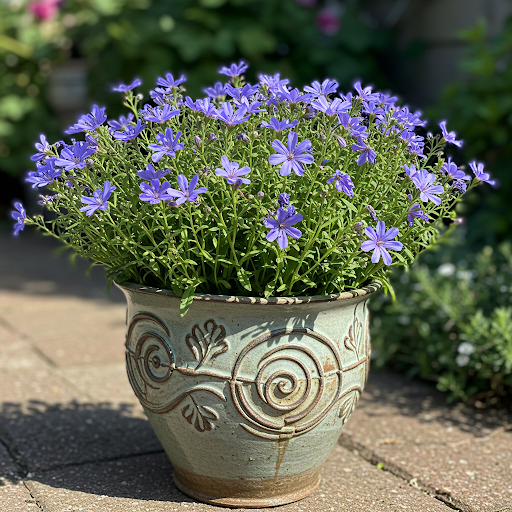
Browallia
For more detailed botanical information and to explore the diverse world of Browallia, you can visit the Wikipedia page on Browallia.
Important Note: Browallia plants are generally considered non-toxic to humans and pets, making them a safe and attractive choice for households with children and animals. The primary care benefits of Browallia in pots are their exceptionally long blooming season, abundant and delicate star-shaped flowers, cool and soothing color range, shade tolerance, self-cleaning nature, and relatively easy care, bringing enduring beauty and soft, cool colors to your partially shaded outdoor spaces for many months. With these simple care practices, you can enjoy a season filled with the abundant charm of Browallia in your outdoor containers.
KC2-GS
By greenship|2024-08-16T06:30:21+00:00August 16, 2024|Categories: Hand-carving Series|
20YB
By greenship|2024-08-16T05:37:57+00:00August 16, 2024|Categories: Hand-carving Series|
11TH
By greenship|2024-08-13T02:50:25+00:00August 13, 2024|Categories: Hand-carving Series|
KC2-11VH
By greenship|2024-08-16T06:19:28+00:00August 16, 2024|Categories: Hand-carving Series|
HS
By greenship|2024-08-13T06:45:17+00:00August 13, 2024|Categories: Hand-carving Series|
Modern Plant Pots with Drainage – Indoor & Outdoor Use (6″ Widths)
By greenship-seo|2025-04-10T06:29:43+00:00February 6, 2025|Categories: Hand-carving Series|Tags: Decorative Flower Pots|

